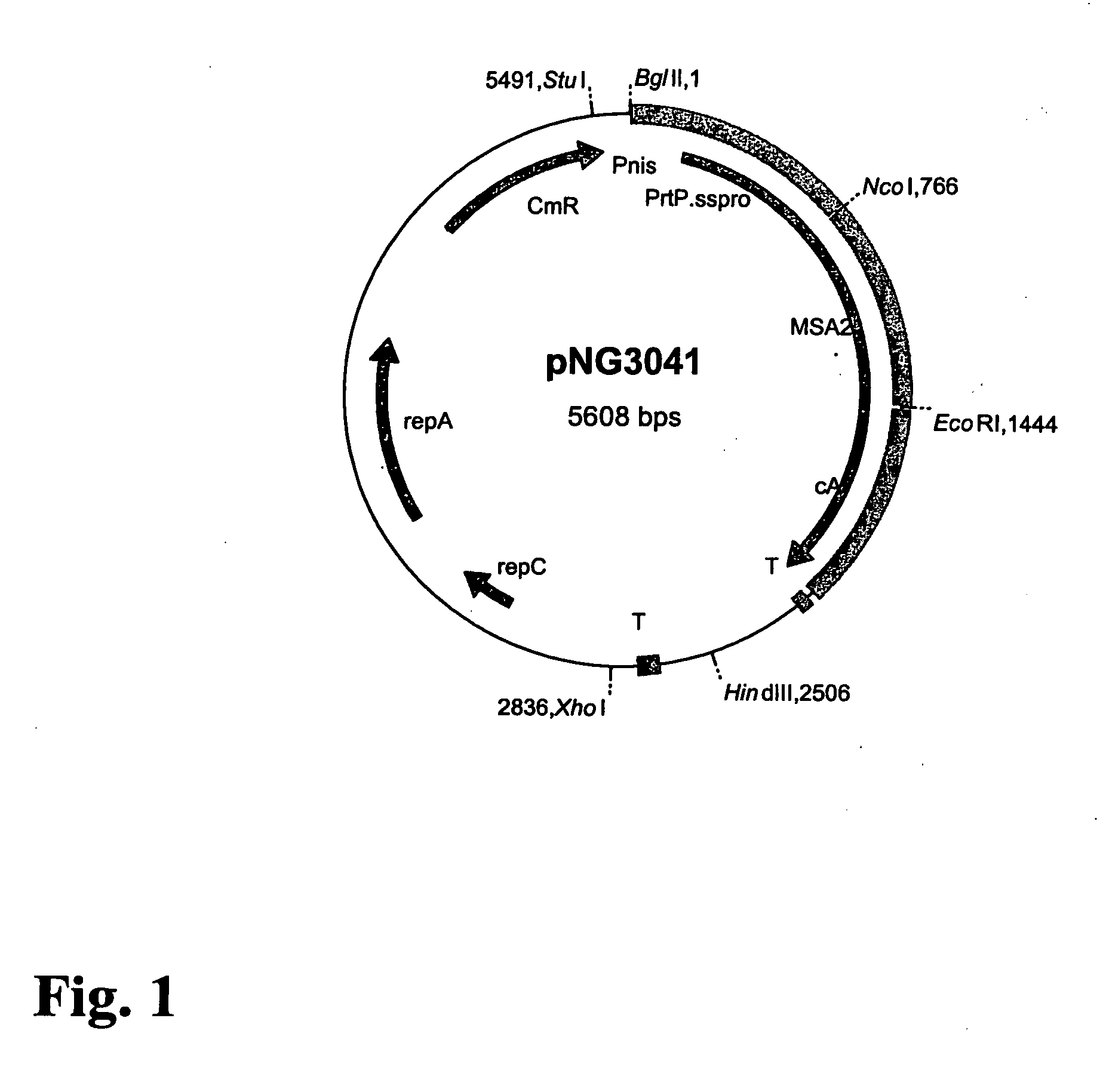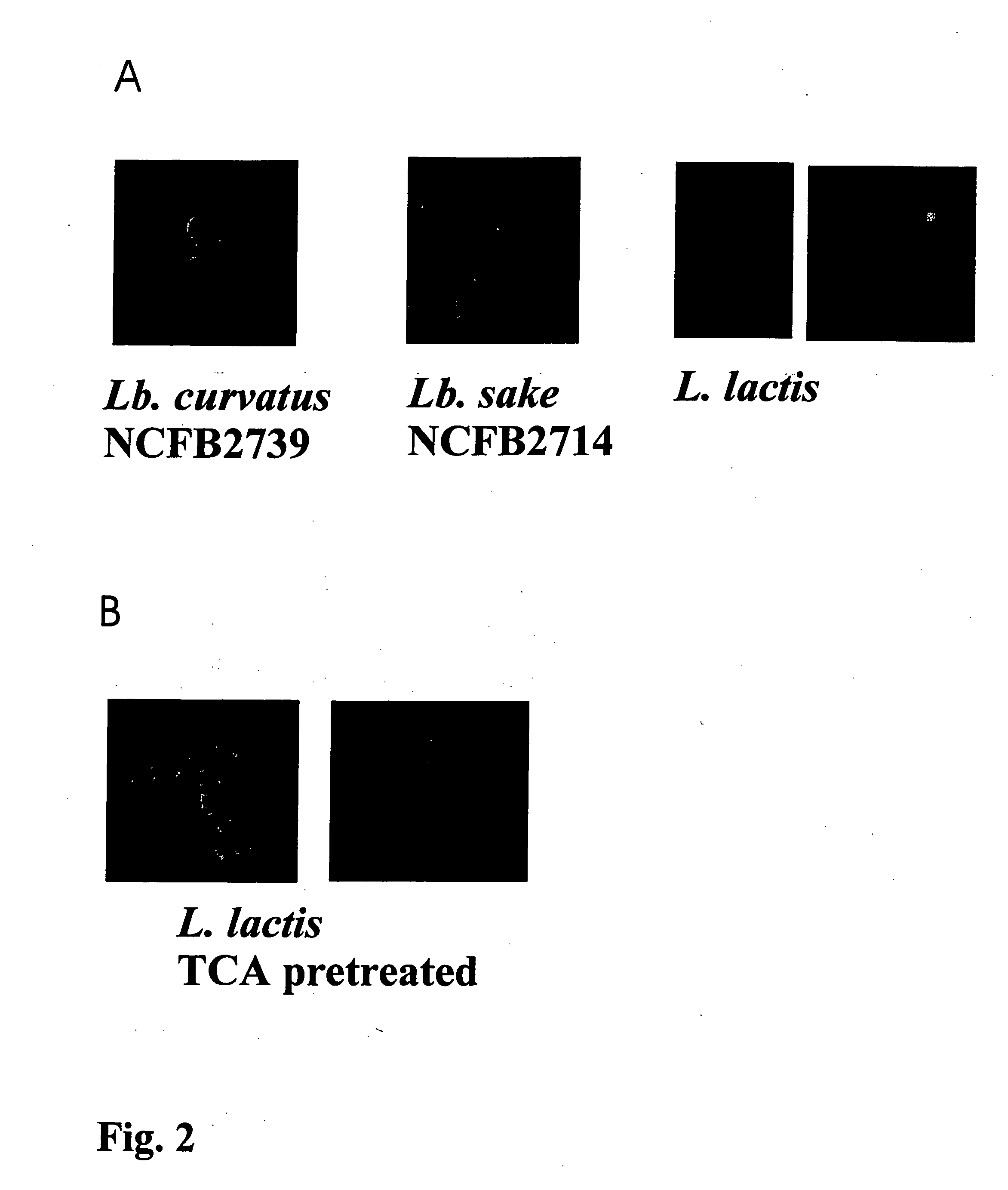Method to provide bacterial ghosts with antigens
a technology of antigens and ghosts, applied in the field of methods, can solve the problems of methods that do not yield ghosts, methods that do not allow targeting with acma cell-wall binding domains, homologs or functional derivatives, and achieve the effect of reducing the risk of generating undesirable immune responses
- Summary
- Abstract
- Description
- Claims
- Application Information
AI Technical Summary
Benefits of technology
Problems solved by technology
Method used
Image
Examples
example 2
Oral Immunizations of Rabbits with Non-Recombinant Lactococcus lactis Preloaded with the Plasmodium falciparum Malaria Antigen MSA2 Fused to the Lactococcal AcmA Protein Anchor
[0094] In Example 1, a technology is described that efficiently binds protein hybrids when externally added to the cell surface of non-recombinant gram-positive bacteria by means of an AcmA-type protein anchor. This technology provides the possibility to provide bacteria or bacterial cell walls with new traits without introducing recombinant DNA into them. The immunogenicity in rabbits of the Plasmodium falciparum merozoite surface protein, MSA2 of strain 3D7 (Ramasamy et al. 1999), presented on the cell surface of non-recombinant non-living L. lactis cells as an AcmA anchor fusion protein was investigated.
Materials and Methods.
[0095] Bacterial Strains and Growth Conditions. The L. lactis strain which produces MSA2::cA, the strain's growth conditions, the induction for expression, the TCA pretreatment of t...
example 3
pH-Dependent Cell-Wall Binding of AcmA Protein Anchor Homologs and Hybrids
[0111] The cell-wall binding domain or anchor of the lactococcal cell-wall hydrolase AcmA includes three repeats of 45 amino acids that show a high degree of homology (Buist et al. 1995). These three repeats belong to a family of domains that meet the consensus criteria as defined in PCT publication WO 99 / 25836 and can be found in various surface-located proteins in a wide variety of organisms. Another feature that most of these domains have in common is that their calculated pI values are high, approximately 8 or higher (Table 3). The pH used in previous binding experiments with MSA2::cA (i.e., Examples 1 and 2) was approximately 6, indicating that the binding domain was positively charged.
[0112] The AcmA protein anchor homolog of the lactococcal cell-wall hydrolase AcmD (cD) (Bolotin et al. 2001) also includes three repeats (FIG. 16) with a calculated pI that is lower (approximately pI 3.8) than that of th...
example 4
Induction of Cellular Immune Responses in Mice after Oral Immunizations with Lactococcal Ghosts Displaying the Malaria Plasmodium falciparum Antigen MSA2 Fused to the Lactococcal AcmA Protein Anchor
[0118] Non-genetically modified non-living Lactococcus lactis cells (ghosts) preloaded with the Plasmodium falciparum MSA2 antigen fused to the AcmA protein anchor (MSA2::cA) were used to orally immunize mice in a similar way as described herein with reference to Example 2. In this experiment, the question of whether immunizations through the oral route with the non-recombinant non-living Ghosts carrying MSA2::cA on their surface (Ghosts-MSA2::cA) can elicit typical Th1-type immune responses, such as IgG2 antibodies and gamma-interferon (γIFN)-producing T cells in the spleen is addressed. These responses are particularly relevant to obtain immunity for pathogens, such as malaria, that undergo stages in their life cycle where they are not in the blood but hide in cells.
Materials and Met...
PUM
| Property | Measurement | Unit |
|---|---|---|
| pH | aaaaa | aaaaa |
| pH | aaaaa | aaaaa |
| concentration | aaaaa | aaaaa |
Abstract
Description
Claims
Application Information
 Login to View More
Login to View More - R&D
- Intellectual Property
- Life Sciences
- Materials
- Tech Scout
- Unparalleled Data Quality
- Higher Quality Content
- 60% Fewer Hallucinations
Browse by: Latest US Patents, China's latest patents, Technical Efficacy Thesaurus, Application Domain, Technology Topic, Popular Technical Reports.
© 2025 PatSnap. All rights reserved.Legal|Privacy policy|Modern Slavery Act Transparency Statement|Sitemap|About US| Contact US: help@patsnap.com



